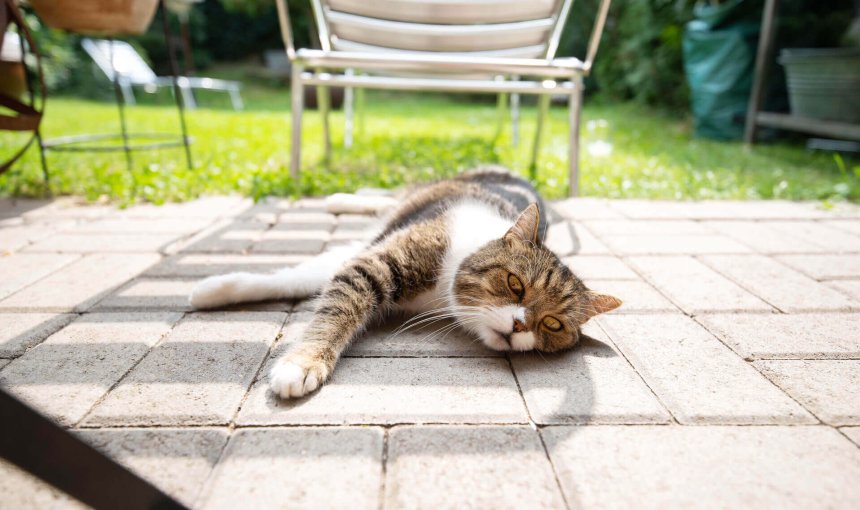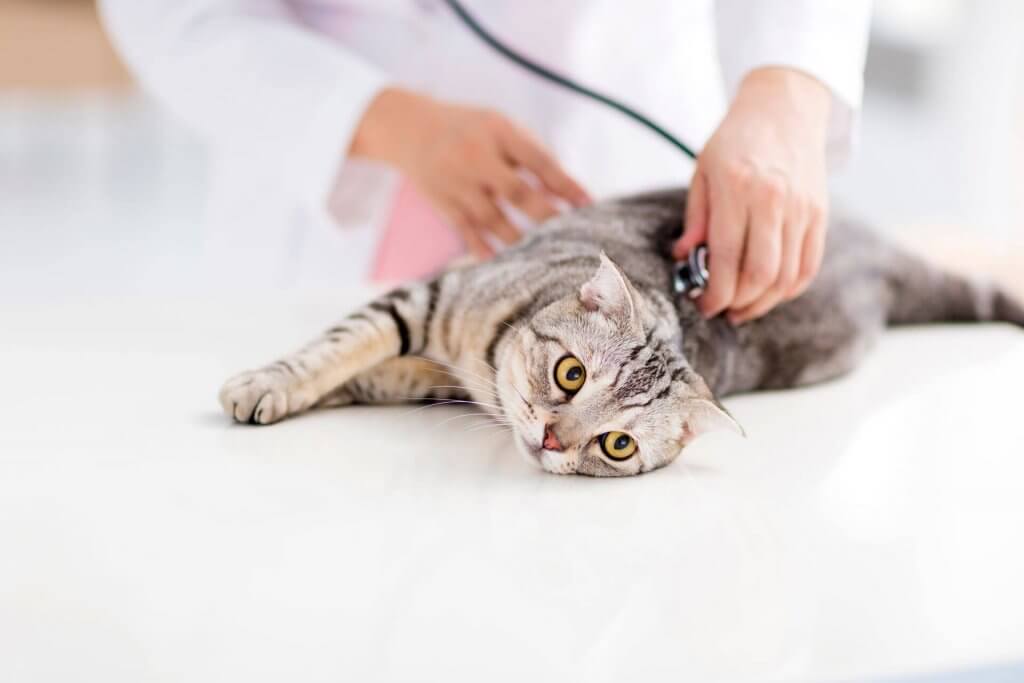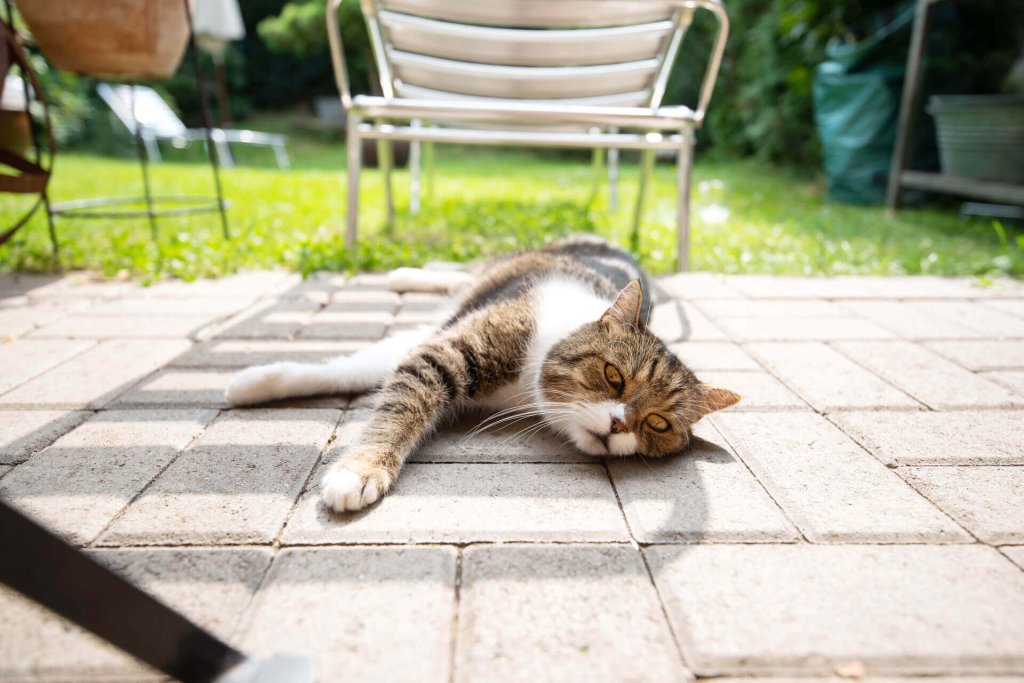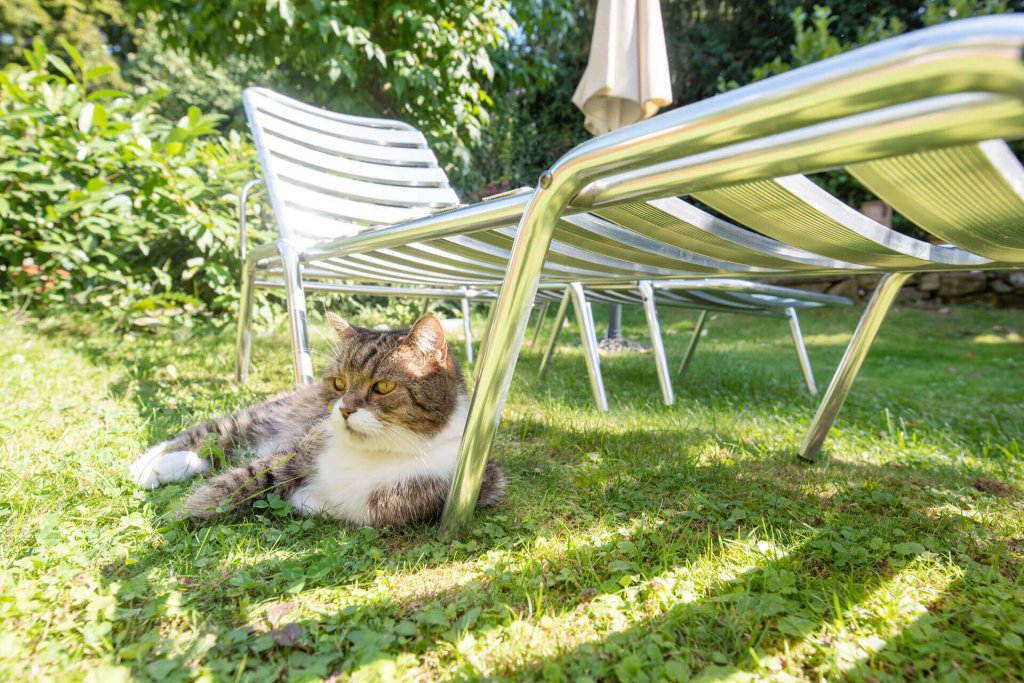Heat Stroke In Cats: Common Causes And How To Help Your Cat To Cool Off
Cats love to warm up in the sun, but how much heat is too much? Learn how to avoid dangerous overheating in your cat with these tips.

Basking in a sunny spot is typical feline behavior, no matter if you have an indoor or outdoor cat. But when your cat experiences too much heat and has no way to cool off, it can lead to heat exhaustion and deadly heat stroke. We’re here to help you avoid dangerous conditions like heat stroke in cats, so learn how to keep your kitty healthy, safe and cool, right here.
- What is heat stroke in cats?
- What is the difference between heat stroke and heat exhaustion in cats?
- How do cats sweat and manage their body temperature?
- Reasons that cats become overheated
- Signs of heat exhaustion or heat stroke in cats
- Causes of heat stroke in cats
- How to take a cat’s temperature?
- How to cool down a cat
- How to prevent heat stroke in cats
- Ideal indoor temperature for cats
- Hydrating your cat to beat the heat
- Recovery of heat stroke in cats
What is heat stroke in cats?
We often hear about heat stroke in dogs, but rarely in cats. That doesn’t mean your kitty is not at risk for this life-threatening condition.
Heat stroke occurs when your cat’s body temperature becomes dangerously elevated. This condition most often occurs when your pet is in a very hot environment and has no way escape or cool off.
Heat stroke is life-threatening for any animal (or human). Without quick action and veterinary care, your cat could collapse or even die.
What is the difference between heat stroke and heat exhaustion in cats?
Heat stroke always begins with heat exhaustion. If heat exhaustion is not treated, it could progress to deadly heat stroke.
The difference between heat exhaustion and heat stroke lies in the cat’s internal body temperature.
A cat’s normal internal body temperature is 100o F to 102.5o F. If a cat shows early signs of overheating and is not treated, its internal body temperature will rise above 102.5o F. Above 103o F, the cat experiences heat exhaustion and will attempt to cool itself off. If the body temperature continues to rise above 104o F and the cat is unable to cool itself or is not removed from a hot area, heat stroke will develop.
Heat stroke is a medical emergency. Contact your veterinarian immediately if you suspect your cat is experiencing heat stroke.

Know everywhere your cat goes
See where they are in real-time, no matter how far they go. Get alerts if they roam too far home. Find out where they’ve been and discover their favorite spots. Let others track with you.
How do cats sweat and manage their body temperature?
Cats are naturally good at practicing self-care. If they don’t want to play, run, or go outside on a hot day, they’ll stay indoors and enjoy the air conditioning (and possibly glare at you as they stretch out for a nap on the cool tile floor).
This behavior is important because cats cannot regulate their body temperature in the same way that humans or dogs can. We humans sweat, and when the sweat evaporates, it has a cooling effect. Dogs will pant to cool off.
When cats get too hot and can’t move to a cool place like a cement floor, sink, or bathtub, they don’t have many options for cooling down. They can lick their fur, which has a slight cooling effect as the saliva evaporates. Cats also sweat through their paw pads, but the paw pads are a tiny area so this tactic provides only minimal cooling. Panting is another cooling strategy, but if your cat is panting, they are already in distress. Panting is one of the early signs of heat exhaustion.
When a cat cannot cool themselves down with these methods and they cannot escape the hot environment they are in, their body temperature will rise. The progression from the early signs of overheating to heat exhaustion and to heat stroke can be fast. Once your cat’s temperature rises to heat stroke level, their organ systems, including circulatory, neurologic, and urinary, could begin to shut down.
Reasons that cats become overheated
Cats, as any cat-lover knows, are all about their own personal comfort. Cats usually move to a cool area like a tile floor as soon as they begin to feel too warm. But certain conditions including your cat’s age, weight, and physical characteristics can make your cat more susceptible to overheating.
In hot weather, be on the lookout for early signs of heat stress if your kitty falls into these categories.
- Excessive weight: Cats that are obese or overweight may be more likely to overheat, especially in warm weather.
- Breed characteristics: Some cat breeds, such as Persians, have shorter noses so their airway is shorter as well. This means that when hot air is breathed in, the air has a shorter distance to travel inside the body and therefore has less opportunity to cool off before reaching the lungs.
- Coat characteristics: Long-haired cat breeds, including Persian, Maine coon, ragdoll, and Himalayan, are more prone to overheating due to the thickness and length of their fur.
- Existing medical conditions: Cats with breathing difficulties, heart disease, or who are being treated for other medical conditions may be at higher risk for heat exhaustion and heat stroke.
- Young or advanced age: Kittens and senior cats may be less able to regulate their internal body temperature than healthy cats.
- Excessive anxiety: If a cat is overly anxious, they could be prone to overheating.
If your cat is high-risk and susceptible to overheating for any reason, it’s best to keep them indoors where temperatures are regulated by air conditioning.
Signs of heat exhaustion or heat stroke in cats
As a cat’s body temperature rises and they are unable to cool off, they will first experience the early signs of heat exhaustion. If heat exhaustion is not treated, the body temperature could continue to rise and symptoms will progress, leading to heat stroke. Heat stroke is life-threatening if untreated. Seek veterinary care immediately.
Symptoms of heat exhaustion
If your cat exhibits any of these symptoms, take immediate steps to cool them down. If the early signs of heat exhaustion are not addressed, it can lead to heat stroke.
- Panting or drooling
- Sweating from paw pads
- Excessively licking fur to cool down
- Restlessness or anxiety
- Internal body temperature of 103o F to 104o F
Symptoms of heat stroke
If your cat shows signs of heat stroke, their internal organs may already be shutting down. Seek veterinary care immediately.
- Internal body temperature of 104o F to 105o F or higher
- Rapid breathing
- Rapid pulse
- Red tongue or mouth
- Vomiting
- Diarrhea
- Clumsiness or staggering
- Lethargy or weakness
- Drooling with thick saliva due to dehydration
- Tremors
- Seizures
- Collapse
- Coma

Causes of heat stroke in cats
Certain activities or situations can put any cat, regardless of health condition, at risk of suffering heat exhaustion or heat stroke.
Trapped in a hot environment
The most common causes of heat stroke in cats occur when a cat is trapped in a hot area like a garage, greenhouse, shed, car, outdoors, or clothes dryer. If the cat cannot remove themselves to cool down, they may suffer heat exhaustion or heat stroke.
Always know your cat’s location with Tractive GPS
Lack of access to water
Lapping up chilled water can help your cat stay cool. If the cat is in a warm environment and has no access to drinking water, they may overheat.
Heat stroke when staying outside
If your kitty is an outdoor cat, pay close attention to the outdoor temperature in summer. Make sure that your cat has access to water and a cool, shady spot that is well-ventilated. In extreme heat, bring your cat indoors into the air conditioning. In general, if it’s too hot for you, it’s too hot for your cat.
How to keep your outdoor cat safe and healthy
Even a lanai, catio, or screened-in porch can be too hot for your cat if they can’t get into a shaded area or lack access to drinking water. Always check on your kitty if they are outdoors in warm weather.
Leaving cats inside cars and other vehicles
It’s well-known that leaving a pet inside a closed vehicle (even with the windows cracked) is a recipe for disaster, but it still happens. On a sunny day, temperatures inside a vehicle can climb above 140o F within minutes, trapping your cat with no way to escape the heat. Don’t risk it.
Heat stroke during travel
Many cats, unlike most dogs, dislike car travel. So kitty is already on high alert when you pack them in a travel carrier and load them in the car. Make sure to keep the travel crate out of direct sun for prolonged periods. Close the sunroof, place the crate on the floor of the back seat, and make sure the air conditioning vents are open in the back of the car.
Tips for safe and comfortable road trips with your cat
Excessive exercise
Exercise heats you up, and the same is true for your cat. If your cat enjoys playing or walking with you outside, schedule these sessions for the coolest parts of the day – usually early morning or late in the evening. Avoid intense activity if the outdoor temperature is above 75o F degrees.
When you do take kitty for a walk, protect their feet from hot pavement. On a blazing day, the pavement temperature can rise above 140o F. And that intense heat is also radiating to your pet from the ground. Again, choose the coolest part of the day for this activity.

Previous heat stroke
If your cat has suffered heat stroke in the past, they may be more prone to heat-related stress. Do all you can to protect your kitty from risky situations that could put them in danger of heat stroke.
How to take a cat’s temperature?
Using a pediatric rectal thermometer is the most effective way to take a cat’s temperature and determine if their internal body temperature indicates early signs of heat stress or has risen to dangerous levels.
What is a normal cat temperature?
A cat’s normal internal body temperature is between 100o F to 102.5o F. Any temperature within this range is acceptable, and your cat may have their own “normal” temperature within this span. Body temperatures above 103o F could signal that something is wrong, so it’s best to have your cat evaluated by a veterinarian. Elevated temperatures could signal heat stress or other conditions like fever or infection. Temperatures above 105o F are life-threatening.
How to check a cat’s temperature with a thermometer
The most accurate way to take a cat’s temperature by inserting a pediatric rectal thermometer into the cat’s rectum. Taking a cat’s temperature can be challenging if you have not done it before. It may help to have another person with you to help.
You will need:
- A blanket or towel to wrap your cat in to prevent wriggling.
- Gloves or a long-sleeved shirt to cover your arms and hands to prevent scratches.
- A pediatric rectal thermometer. A digital thermometer will give you faster results. Keep this thermometer separate from yours so it’s only used on the cat. Avoid using an old-style mercury thermometer, which could break if your cat struggles during this procedure.
- Vaseline or other lubricant.
How to take your cat’s temperature:
- Put lubricant on the rectal thermometer.
- Wrap your cat in a towel or blanket and have someone hold the cat.
- Insert thermometer into the cat’s rectum, about ½ to 1 inch. Leave it in for a few minutes, or until the digital thermometer beeps.
- Remove the thermometer and read the temperature.
- Clean the thermometer thoroughly.
It’s also possible to take a cat’s temperature by inserting a thermometer in the ear, but this is not always accurate.
If the thermometer shows that your cat’s temperature is above 102.5o F, take immediate steps to cool them off and contact your veterinarian if their temperature continues to climb.
How to check a cat’s temperature without a thermometer
A thermometer is the most accurate way to gauge your cat’s internal body temperature. But if you do not have a thermometer available, there are other ways to check for elevated body temperature.
- Check your cat’s nose. Is it moist or dry? Dryness can indicate that your cat is too hot or is dehydrated.
- Feel your kitty’s ears. Cats’ ears normally feel warm, but when cats overheat, their ears feel extremely hot.
If your cat is panting, lethargic, or exhibiting any other signs of heat exhaustion or heat stroke, seek immediate medical care and cool them off.
How to cool down a cat
If you suspect your cat is experiencing heat exhaustion or heat stroke, you should help them cool off immediately.
Remove your cat from the hot location and go somewhere cool such as an air-conditioned building or into deep shade. Offer your cat cool water, but do not force them to drink. It may help to lay your cat on wet towels. Don’t wrap your cat in the wet towels as this may actually trap heat. If possible, place ice packs between the cat’s legs. Bring your cat to the veterinarian as soon as possible.
If the veterinarian determines that your cat is suffering from heat exhaustion or heat stroke, they may offer intravenous fluids to cool your cat internally. Your cat’s body temperature will be closely monitored. If organ damage is suspected, your cat may be hospitalized.

How to prevent heat stroke in cats
Since the most common cause of heat stroke in cats is being trapped in hot environments, the most important thing is to never leave your cat in a hot place with no way to escape or cool off. Here are some more ways that you can prevent heat stroke in cats:
- Keep your cat indoors, preferably with air conditioning, on very hot days.
- Always have fresh cool water available for your cat.
- Never leave your cat, or any pet, inside a parked car.
- Always check the clothes dryer before starting to make sure your cat is not snoozing inside.
- If your cat is in a crate or pet carrier, keep them out of direct sunlight.
- Check sunrooms, sheds, garages, or other confined spaces where your cat could be trapped.
A GPS cat tracker from Tractive shows you your cat’s location in real time on your smartphone
Ideal indoor temperature for cats
A rule of thumb when setting indoor temperatures is that if you are comfortable, your cat probably will be, too. Depending on the season, setting your thermostat somewhere between 65-75o F is a good place to start.
Hydrating your cat to beat the heat
Staying hydrated is important for health. Cats don’t drink copious amounts of water, but if you set out a bowl of fresh cool water every morning, kitty will take quick sips throughout the day. Experts suggest that cats should drink one ounce of water per pound of body weight per day. That means a 10-pound cat should drink about 10 ounces of water per day – a little more than one measuring cup.
If you cat has multiple hangouts – such as inside your home, on a screen porch, garage, or barn – be sure to place fresh water in each of these locations every day.
Cat Not Drinking Water? Here’s What To Do
Recovery of heat stroke in cats
If your cat suffered from heat stroke, they may need to be monitored for organ damage, which may not show up immediately. Watch for signs such as blood in the urine, which could signal kidney damage.
But true to their reputation for having nine lives, most cats can completely recover from heat stroke with proper care.




